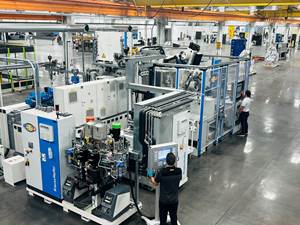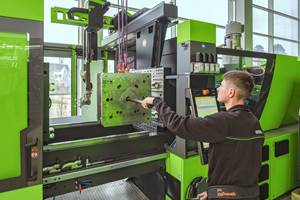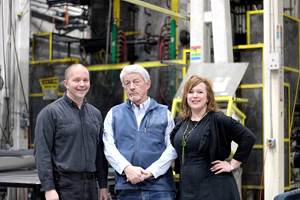Maintenance Training? Show Me the Money
Training works best if a goals are set and a plan is established to meet them.
Let’s face it, much of the manufacturing industry “training” that takes place ends up being more of a one-time “event” that never gets legs or provides any real, lasting value. Intentions might be good, and while actual training may be conducted and information exchanged, some people still ho-hum the idea of training, passing it off as wasted time because when the training is over… it’s over.
In this world of ROI decision making, for something to have real value there must be a goal in mind and some metrics to measure short- and long-term success—or lack of it.
Maintenance training can be especially difficult to justify because there is a perception that if someone has been doing a specific job for many years, and their work is acceptable, then why would they need to be trained? The reality is that longevity at a job does not always guarantee proficiency. When it comes to trade skills, in many cases longevity can actually work against a continuous-improvement mindset as time in grade breeds security and complacency.
Another rationalization is, “We are just too busy keeping things running to stop and train.” Obviously these are all excuses to hide the real issue, which is having faith in the value of training relative to everything else that needs taking care of in the shop. So the question is, “What is better for me and my company: Dealing with daily, real-world issues or a perceived ROI for the time and money it takes to attend training.” To some it’s a no-brainer—fix it first, train later.
TRAINING FLAVORS
Training comes in all forms, ranging from college degrees to hotel seminars to YouTube videos. Knowing what is best for you and your company requires a training plan. A good plan requires a means to measure certain metrics that have an impact on whatever it is you want to improve. The fewer the metrics, the less the value proposition of the training tends to be. In a trade skill, where talent is dictated by one’s intellectual attributes (knowledge of the job) along with the physical requirements (using tools), confusion can occur over what is really needed to get better.
For instance, one company I talked to had just sent their four mold-repair technicians to a local college to take 40 hr each of math, blueprint reading, and electrical training. The training was not only expensive, but much shop work went undone in the 160 man-hr of time missed. When I inquired as to the real need and proposed payback of this training, I was met with silence. The supervisor said they wanted the group to be trained in something that would benefit their job and this sounded like it fit the bill. After diving a bit deeper into how much these specific skills are used on a day-to-day basis to keep his molds running, he answered, “Probably not much, but HR wanted it this way.” Oh.
The problem with this is no one really knew, because they couldn’t measure how much the lack of these skills really affected the mold performance and repair aspects of their molding business. While the above skills sound like a good fit with a typical repair technician, they rarely affect job and mold performance as a whole.
WORK THE PLAN
Simply attending training for the sake of being able to say the staff receives ongoing training will sound good, but at the end of the day the deliverables won’t be there. In certain skilled trades like electricians and plumbers, training is mandated and skills are tested to a state or federal code level to qualify to provide a service. In mold maintenance, the metrics that really affect the job can be harder to define, but define we must or the training will only be a nice break from work.
In our mold-maintenance training facility we see hundreds of attendees that are eager to learn, but few come with a specific objective in mind; we know this because we ask. Before they leave, we make sure they know exactly what is needed to efficiently maintain molds and have them make a list of specific goals so that we can follow-up over time to make sure our deliverables and their goals are being met and an ROI will be realized.
A large part of the value of training is to help attendees understand the “process” of mold maintenance, and the specific sequence of events that should occur when any mold is worked on and exactly what metrics should be measured.
Without knowledge of this maintenance process and metrics, there is nothing to guide them towards a continuous-improvement strategy, so one is left to wander in the smoke of reactive firefighting methods where competency is judged by the fires that are knocked down… but never extinguished. This is the recipe for maintenance mediocrity: Working hard and getting nowhere.
We also see companies saving a lot of money through disciplined efforts to acquire specific maintenance knowledge by learning to use powerful data tools for mold comparisons, defect trends, frequencies, and related corrective actions that lead to understanding root causes and to continuous improvement. Others need and learn the secrets of trade skills such as welding, polishing, stoning, and fitting that typically take years of on-the-job training to be effective. Targeted training cuts these years and many dollars off this learning curve while allowing molds to run longer and with fewer issues.
Don’t let training be an event. Communicate with your trainer where additional knowledge and or hand skills are needed. Work with them to develop an ROI plan based on real metrics that will allow you to measure success. Then you will see the money.
About the Author
Steven Johnson is the operations manager for ToolingDocs LLC, part of the PCIC Group of Companies. Steve also has is own business, MoldTrax in Ashland, Ohio. He can be reached at steve.johnson@toolingdocs.com or (419) 289-0281
Related Content
The Cost of High Employee Turnover in Injection Molding: Why Retention Matters
Starting in molding in 1993 and clocking in for nearly every job on the floor over the intervening decades, I’ve seen all sides of the hiring, training and retention process in the industry. Here are my thoughts on how to keep your most important asset — your people.
Read MoreKraussMaffei and NIAR Propel Injection Molded Thermoplastic Composites
The maker of plastics processing equipment has placed a machine and an injection molding expert in NIAR’s ATLAS lab in Wichita, Kansas, to help molding, composites and aerospace take off.
Read MoreMold-Change Time Targeted with Training, Technology
Engel is offering technology and training to molders to help them optimize their mold-changing process.
Read MoreBlow Molder Confer Plastics Celebrates Golden Anniversary & the ‘American Dream’
This family-run firm fills a specialized niche with a culture of innovation and environmental stewardship that realizes the dreams of its founders, its employees and its customers.
Read MoreRead Next
People 4.0 – How to Get Buy-In from Your Staff for Industry 4.0 Systems
Implementing a production monitoring system as the foundation of a ‘smart factory’ is about integrating people with new technology as much as it is about integrating machines and computers. Here are tips from a company that has gone through the process.
Read MoreLead the Conversation, Change the Conversation
Coverage of single-use plastics can be both misleading and demoralizing. Here are 10 tips for changing the perception of the plastics industry at your company and in your community.
Read MoreFor PLASTICS' CEO Seaholm, NPE to Shine Light on Sustainability Successes
With advocacy, communication and sustainability as three main pillars, Seaholm leads a trade association to NPE that ‘is more active today than we have ever been.’
Read More














